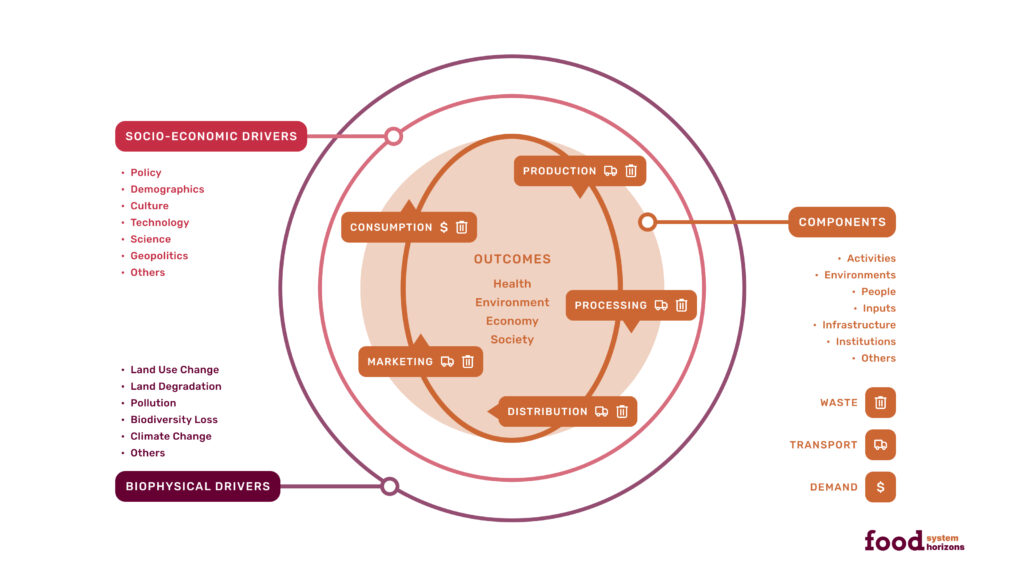What is a food system?
The food system figure shows the individual components of the food system that include production, processing, distribution, marketing, and consumption. The components are connected by a circle that indicates that they impact each other. Within each component, transport is involved, and food loss or waste occurs. Consumption is driven by consumer demand, which impacts the rest of the food system.
The food system components sit within a shaded circle labelled components. This indicates that each food system comprises activities, environments, people, inputs, infrastructure, institutions, and other factors, and these are listed.
In the centre of the diagram, health, environment, economy, and society are listed to show the breath of outcomes that the food system influences. These outcomes are shown at the centre of the food system to indicate that they are interrelated with the individual food system components and impact each other.
Socio-economic and biophysical drivers are shown in outer concentric circles to indicate that they influence the whole food system. Socio-economic drivers that are listed include policy, demographics, culture, technology, science, geopolitics, and others. Biophysical drivers that are listed include land use change, land degradation, pollution, biodiversity loss, climate change, and others.
The food system showing individual components (e.g., production), outcomes and drivers. Citation: Food System Horizons 2024.
The food system
The term food system refers to all the components that are required to feed people. These interconnected components include production, processing, transport, distribution, marketing, consumption, and waste as well as the associated activities, people, and inputs.
The interactions and feedback between these components and socioeconomic and biophysical drivers make for a dynamic system and result in a range of social, environmental, and economic outcomes.
Why take a systems perspective
Viewing the food system as a whole helps to inform solutions to a growing set of sustainability, equity, and nutritional challenges that have not been adequately addressed by focusing on the system’s individual components.
The food system comprises multiple interconnected components that include activities, people, environments, inputs including the natural resource base, infrastructure, and institutions. Food system components include production, processing, transport, distribution, marketing, consumption, and waste.
Outcomes
The food system has multiple intended and unintended outcomes, some of which can arise from surprising interactions between food system components. Outcomes are often interrelated and can be positive or negative.
Outcomes of the food system are often categorised to include:
- Health, nutrition and food security
- Society – e.g., culture, livelihoods and employment
- Environment – e.g., soil health, erosion, biodiversity loss, greenhouse gas emissions, pollution, food loss and waste
- Economy – e.g., production, trade, and wealth accumulation.
Drivers
The food system is affected by multiple socioeconomic and biophysical drivers. These drivers can enable or constrain the functioning and outcomes of the food system. As drivers change over time, they can require an adaptation of food system goals and functional capability necessary to meet those goals. Some drivers are interconnected and when combined can have surprising impacts on the food system.

